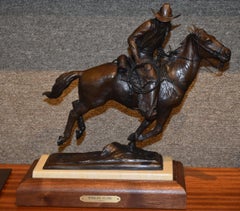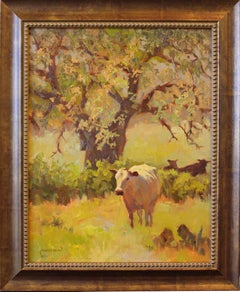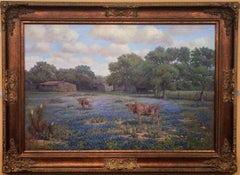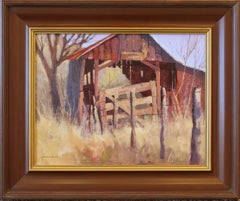Want more images or videos?
Request additional images or videos from the seller
1 of 18
Newcomb Macklin Frame Co.Newcomb Macklin Hand Carved Gold Leaf Frame. Fits 25 x 30 Painting. Ext. 30 x 35Circa 1920s
Circa 1920s
$2,600List Price
About the Item
About the Seller
5.0
Vetted Professional Seller
Every seller passes strict standards for authenticity and reliability
Established in 1974
1stDibs seller since 2017
102 sales on 1stDibs
Typical response time: 1 hour
Authenticity Guarantee
In the unlikely event there’s an issue with an item’s authenticity, contact us within 1 year for a full refund. DetailsMoney-Back Guarantee
If your item is not as described, is damaged in transit, or does not arrive, contact us within 7 days for a full refund. Details24-Hour Cancellation
You have a 24-hour grace period in which to reconsider your purchase, with no questions asked.Vetted Professional Sellers
Our world-class sellers must adhere to strict standards for service and quality, maintaining the integrity of our listings.Price-Match Guarantee
If you find that a seller listed the same item for a lower price elsewhere, we’ll match it.Trusted Global Delivery
Our best-in-class carrier network provides specialized shipping options worldwide, including custom delivery.You May Also Like
Acrylic painting on canvas of the Arc de Triumph, in Paris, with striking color
Located in Jerusalem, IL
In this vibrant and expressive painting, by the artist Sergei Moskalev captures the timeless grandeur of the Arc de Triomphe in Paris. Rendered in bold strokes and a rich, dynamic pa...
Category
21st Century and Contemporary Paintings
Materials
Gold Leaf
$5,800
H 17.72 in W 23.23 in
Dog in a landscape French oil painting on canvas 19Th by Augustin Luc Demoussy
Located in Gavere, BE
Dog in a landscape French oil painting on canvas 19Th by Augustin Luc Demoussy
French oil painting signed and date 1947
French painter and lithographer, born October 5 1809 in Paris...
Category
1840s French School Animal Paintings
Materials
Gold Leaf
$8,252
Free Shipping
H 19.3 in W 22.45 in D 1.58 in
Wintertime forest landscape oil painting on canvas by Louis Clesse 20Th c.
By Louis Clesse
Located in Gavere, BE
"Wintertime forest landscape" oil painting on canvas by Louis Clesse 20Th c.
Wonderfull oil on canvas by Louis Clesse , Belgian School (1889 -1961 ).
Clesse was a Belgian figurative...
Category
1920s Impressionist Landscape Paintings
Materials
Gold Leaf
$4,836
H 25.2 in W 33.08 in D 3.94 in
Oil On Canvas "reflections In The Stream" By Georges De Sloovere Impressionist
Located in Gavere, BE
"Oil On Canvas "reflections In The Stream" By Georges De Slovere Impressionist Painter "
Biography:
De Slovere Georges was born on August 4, 1873 in Bruges.
He studied at the Academy of Fine Arts in Bruges and held grateful memories of his beloved master, Van Hove Edmond.
In 1895, he continued his studies at the Academy of Fine Arts in Brussels where he won numerous prizes.
His style is neo-impressionist.
He is a member of the National Association of Painters and Sculptors of Belgium.
In 1918, he became a professor at the Academy of Bruges.
He held this position until 1925.
Gustaaf Buffel was one of his students.
Additional information:
Title: Reflections in the stream
Medium: oil on canvas
Signature: signed lower left
Provenance: Belgian private collection
Canvas dimensions: 50 cm x 60 cm
Dimensions framed: 70 cm x 80 cm
Condition: Very good condition (restored, yellow varnish has been removed)
Artist: Georges de Sloovere...
Category
Early 1900s Impressionist Landscape Paintings
Materials
Gold Leaf
$6,979
Free Shipping
H 19.69 in W 23.63 in D 3.15 in
Old oil on Canvas 18th century , after Jean baptiste Oudry French school
Located in Gavere, BE
Very beautiful old artwork of the end of the 18th century ,after Jean Baptiste Oudry " Loup pris au piege ",
an example of which is exhibited at th...
Category
1890s French School Animal Paintings
Materials
Gold Leaf
$6,608 Sale Price
20% Off
H 29.93 in W 37.8 in D 2.37 in
Hunting Dog cubs , oil painting on canvas by Caspar Von Reth 19th c.
By Caspar von Reth
Located in Gavere, BE
Hunting Dog cubs , oil painting on canvas by Caspar Von Reth 19th c.
German animal and portrait painter and sculptor (1850 to 1913 Aachen).
Studied with A. Fischer in Aachen, Wolff...
Category
1890s Animal Paintings
Materials
Gold Leaf
$7,063
Free Shipping
H 20.87 in W 23.23 in D 2.37 in
Late Summer Full Moon – Oil Atmospheric Nature Painting, Abstraction, Expression
By Agnieszka Zawisza
Located in Salzburg, AT
Agnieszka Zawisza (born 1970) is a painter, visual artist and art teacher. She studied at the Warsaw Art Academy, Department of Painting (1994-2000), obtaining a Master's degree with...
Category
2010s Contemporary Abstract Paintings
Materials
Gold Leaf
$1,017
H 15.75 in W 19.69 in D 0.79 in
Red Rocks
By Lani Vlaanderen
Located in Loveland, CO
Red Rocks by Lani Vlaanderen
30x24" Oil Painting
38x32" framed, gold leaf on wood.
Signed lower right
Landscape featuring sandstone formation with greenery ...
Category
2010s Impressionist Landscape Paintings
Materials
Gold Leaf
"Happiness in the Air" Expressionist Landscape with Waterfall
Located in Austin, TX
A colorful and idyllic expressionist landscape with a waterfall by Dominique Boisjoli.
38" x 26" Acrylic and Gold Leaf on Paper
Category
21st Century and Contemporary Expressionist Landscape Paintings
Materials
Gold Leaf
$4,830
H 38 in W 26 in
The Unknown
By Alexis Kandra
Located in Jersey City, NJ
"The Unknown," (2022) by wildlife artist Alexis Kandra is an oil painting gilded with metal foil on wood panel, measuring 36" X 36". Her newest piece, the painting features an earthy landscape appointed with beautiful wildlife -- a rooster, a bull frog, a pidgeon / dove, white horses, red robin...
Category
2010s Contemporary Animal Paintings
Materials
Gold Leaf
More From This Seller
View All"WORKING AS ONE" COWBOY WESTERN BRONZE ORIGINAL STUDIO COPY
By G. Harvey
Located in San Antonio, TX
G. Harvey (Gerald Harvey Jones)
(1933-2017)
San Antonio, Austin, and Fredericksburg Artist
Image Size: 16 x 15 tall
Medium: Bronze Sculpture / Studio Copy
1984
"Working as One"
G. Harvey, known for paintings closely linked in mood and subject matter to Edouard Cortes [1882-1962], G Harvey creates romanticized street scenes of turn of the century towns in America. Rain slick streets reflect urban lights, and the weather is obviously cold. He grew up in the rugged hills north of San Antonio, Texas from where herds of longhorn cattle were once driven up dusty trails to the Kansas railheads. His grandfather was a trail boss at 18 and helped create an American legend for his grandson. So, the American West is not only the artist's inspiration but his birthright. Harvey's early interest in sketching and drawing slowly evolved into a passion for painting in oils. After graduating cum laude from North Texas State University, Harvey took a position with the University of Texas in Austin, but he soon realized that weekends and nights at the easel did not satisfy his love of painting. He abandoned the security of a full-time job in 1963 and threw his total energy into a fine art career. Harvey paints the spirit of America from its western hills and prairies to the commerce of its great cities. His original paintings and bronze sculptures are in the collections of major corporations, prestigious museums, the United States government, American presidents, governors, foreign leader and captains of industry. The Smithsonian Institution chose Harvey to paint The Smithsonian Dream, commemorating its 150th Anniversary. The Christmas Pageant of Peace commissioned Harvey to create a painting celebrating this national event. He has been the recipient of innumerable awards and the subject of three books. Today, G. Harvey lives in Fredericksburg, Texas, with his wife Pat in a 150-year-old stone home built by German settlers. His studio and residence are nestled within the Historic District of Fredericksburg. It is obligation of fine artists to present us with more than pretty pictures. They must also make us feel. Among the western painters of today, there is none more capable of accomplishing this than G. Harvey. In his paintings, the viewer into only sees the physical elements of his subject, but also senses the mood that surrounds them. It is a remarkable aspect of fine art, which few artists are able to master. Gerald Harvey Jones was born in San Antonio, Texas, in 1933. His grandfather was a cowboy during the trail-driving era when legends grew up along the dusty trails north from Texas. Family stories of wild cattle and tough men were absorbed by a wide-eyed boy and became the genesis of G. Harvey's art. A graduate in fine arts at North Texas State University, Harvey taught full-time and painted nights and weekends for several years. It was through painting that he found his greatest satisfaction, and his native central Texas hill country provided the inspiration for most of his earliest work. With the development of his talent and the growth of his following, Harvey began to expand his artistic horizons. He left teaching and concentrated on a career in fine art. He sought the essence that is Texas and found it not only along the banks of the Guadalupe, but in cow camps west of the Pecos, and in the shadows of tall buildings in big Texas cities. The streets of Dallas once echoed with the sound of horse's hooves and the jingle of spurs. Historic photographs reveal what it looked like, but only an artist like Harvey can enable a viewer to experience the mood and flavor or the time. Contemporary west art has too often centered on the literal representations from its roots in illustrations. Artists like G. Harvey take us a step further, to the subjective impressions that are unique to each great talent, and which constitutes something special and basic to fine art expression. Harvey is a soft-spoken and unassuming man who cares deeply about what he paints without becoming maudlin or melodramatic. We sense there is more in each Harvey painting than just that which is confined to the canvas. Resources include: The American West: Legendary Artists of the Frontier, Dr. Rick Stewart, Hawthorne Publishing Company, 1986 Artist G. Harvey grew up in the rugged hills north of San Antonio, Texas from where herds of longhorn cattle were once driven up dusty trails to the Kansas railheads. His grandfather was a trail boss at 18 and helped create an American legend. So, the American West is not only the artist's inspiration but his birthright. Harvey's early interest in sketching and drawing slowly evolved into a passion for painting in oils. After graduation cum laude from North Texas State University, Harvey took a position with the University of Texas in Austin, but he soon realized that weekends and nights at the easel did not satisfy his love of painting. He abandoned the security of a full-time job in 1963 and threw his total energy into a fine art career. Two years as a struggling artist followed, but 1965 brought acclaim for the artist's first prestigious show, The Grand National exhibition in New York, and the American Artists' Professional League presented him with their New Master's Award. President Lyndon Johnson discovered his fellow Texan's talent, became a Harvey collector and introduced John Connally to the artist's work. Connally was enthusiastic about Harvey's art, and, on one occasion, he presented a G. Harvey original to each governor of Mexico's four northern states. Harvey paints the spirit of America from its western hills and prairies to the commerce of its great cities. His original paintings and bronze sculptures are in the collections of major corporations, prestigious museums, the United States government, American presidents, governors, foreign leader and captains of industry. The Smithsonian Institution chose Harvey to paint The Smithsonian Dream commemorating its 150th Anniversary. The Christmas Pageant of Peace commissioned Harvey to create a painting celebrating this national event. He has been the recipient of innumerable awards and the subject of three books. Through his art, our history lives. Today, G. Harvey lives in Fredericksburg, Texas, with his wife Pat in a 150-year-old stone home built by German settlers. His studio and residence are nestled within the Historic District of Fredericksburg. Gerald Harvey Jones, better known as G. Harvey, grew up in the Texas Hill Country listening to his father and grandfather tell stories about ranch life, frontier days in Texas, and driving cattle across the Red River. Early in his career, he began to draw inspiration from that collective memory for paintings that would eventually earn him the reputation as one of America's most recognized and successful artists. His art is rooted in the scenic beauty of the land he grew up in and the staunch independence of the people who live there. He says, "My paintings have never been literal representations. They are part first-hand experience, and part dreams generated by those early stories I heard. They are a product of every place I have been, everything I have ever seen and heard." G. Harvey graduated from North Texas State University. He taught in Austin, but continued to study art in his spare time, eventually devoting full time to his painting. The year 1965 was a turning point when he won the prestigious New Masters Award in the American Artist Professional League Grand National Exhibition in New York. It is often said that in viewing a work of art, one is granted a unique look into the thoughts and expressions of values that give meaning to the artist work. Nowhere does this ring truer than the art of G. Harvey. Though Harvey has had nearly two decades of sell-out shows, an outstanding honor came with a series of one-man shows in Washington, D.C. in 1991. The first was at the National Archives featuring his paintings of the Civil War era, then a selection of paintings of notable Washington landmarks was exhibited at the Treasury Department, culminating in a one-man show of 35 paintings at the Smithsonian Institution during their exhibition of The All-American Horse. His work was featured in Gilcrease Museum exhibitions from 1992-1997. In 1987 his alma matter honored him with a Distinguished Alumni Award. One of Harvey's paintings was featured on the cover of Smithsonian Institution's 150th anniversary engagement book. He now has four books published and resides with his family in The Texas Hill Country. integrity, strength, courage, faith, heritage - these are compelling words that have often been used by collectors and art critics alike to describe that intrinsic value that courses through every original painting or sculpture by artist G. Harvey. Whether drawing inspiration from his own deeply rooted Texas heritage or his world travels with wife Patty, the human experience is fully revealed in his art. He is often credited with technical brilliance as his goal is to approach each subject with discipline, maturity and artistic integrity. Yet beyond this vast and well-schooled knowledge, is a deeper set of values, an inner luminosity that transcends time and place, evoking familiar sights, sounds, moods and emotions. Harvey grew up in San Antonio, Texas. He resides now in Fredericksburg, Texas where he lives in a 150-year-old stone home built by German settlers. Lyndon Johnson introduced his works to John Connally who presented a G Harvey original to the governors of four Northern Mexican states. He celebrated a one-man show at the Smithsonian Institution entitled The All-American Horse. Harvey has always believed that history lives through art including the epic struggle between the states, the western migration, the brief time when horses and automobiles clattered across cobblestones together. He is faithfully able to capture the drama and feeling of such a moment in time.
Please view my 1stdibs store front for other Great Vintage Texas...
Category
1980s Impressionist Landscape Paintings
Materials
Bronze
"SPRING IN HER STEP" TEXAS CATTLE FREDERICKSBURG 22 X 18 FRAMED OPA Member. COW
Located in San Antonio, TX
Chuck Mauldin
Born 1949
Fredericksburg Artist
Image Size: 18 x 14
Frame Size: 22 x 18
Medium: Oil
"Spring In Her Step" Cattle Landscape Texas
A native of Texas, Chuck Mauldin has been painting in oil since the age of twelve. His interest in watercolor and pencil drawing grew during his years spent in Louisiana. With his move back to Texas, he has renewed his focus on oil painting, using this medium in a realistic yet painterly style. Striving to quickly capture color and mood with a direct "alla prima" technique is one of his main objectives in painting outdoors on-location. Cows, cowboys and Native Americans often enrich the landscape in his studio work, while anything can inspire his plein air paintings.
Workshops with Charles Sovek, Kevin Macpherson, and many others have played a significant role in his development as an artist. He is a member of Oil Painters of America and has achieved Signature membership status in the Louisiana Watercolor Society and the Plein Air Artists of Colorado. Chuck has won numerous awards and has had work accepted into prestigious national juried competitions, such as the Oil Painters of America National Show (2020, 2021), Western Regional Show (2016, 2021, 2022) and Salon Show (2016, 2020).
After 28 years in Louisiana, Chuck and his wife, Barbara, moved to Fredericksburg, Texas, in 2005, in order to pursue their passion for art on a full-time basis. In 2008, Chuck started teaching a beginner’s oil painting class and later intermediate classes in composition, landscape painting, and limited palettes. He is represented by Charles Morin Fine Art in Fredericksburg, Texas.
Degrees in chemistry from Southern Methodist University (B.S.) and the University of Texas (PhD) led to Chuck's career in research at ExxonMobil Process Research Labs in Baton Rouge, Louisiana. He presently holds 57 U.S. patents in the field of catalysis. He and Barbara have two sons and a daughter, and 8 perfect grandchildren. An Eagle Scout...
Category
2010s American Impressionist Landscape Paintings
Materials
Oil
"KENDALL COUNTY RANCH" BLUEBONNET LONGHORN FRAMED 53 X 73
By Eric Harrison
Located in San Antonio, TX
Eric Harrison
(Born 1971)
Texas Hill Country Artist
Image Size: 40 X 60
Frame Size: 53 x 73
Medium: Acrylic
2015
"Kendall County Ranch" Longhorn Bluebonnet
Eric Harrison (Born 1971) Texas Hill Country Artist Bluebonnet painting...
Category
2010s Impressionist Landscape Paintings
Materials
Oil
"BARN TO LAST" TEXAS LANDSCAPE NEAR FREDERICKSBURG 21 X 25 FRAMED OPA Member
Located in San Antonio, TX
Chuck Mauldin
Member OPA
Born 1949
Fredericksburg Artist
Image Size: 14 x 18
Frame Size: 21 x 25
Medium: Oil
"Barn To Last" Texas Farm Scene
A native of Texas, Chuck Mauldin has been painting in oil since the age of twelve. His interest in watercolor and pencil drawing grew during his years spent in Louisiana. With his move back to Texas, he has renewed his focus on oil painting, using this medium in a realistic yet painterly style. Striving to quickly capture color and mood with a direct "alla prima" technique is one of his main objectives in painting outdoors on-location. Cows, cowboys and Native Americans often enrich the landscape in his studio work, while anything can inspire his plein air paintings.
Workshops with Charles Sovek, Kevin Macpherson, and many others have played a significant role in his development as an artist. He is a member of Oil Painters of America and has achieved Signature membership status in the Louisiana Watercolor Society and the Plein Air Artists of Colorado. Chuck has won numerous awards and has had work accepted into prestigious national juried competitions, such as the Oil Painters of America National Show (2020, 2021), Western Regional Show (2016, 2021, 2022) and Salon Show (2016, 2020).
After 28 years in Louisiana, Chuck and his wife, Barbara, moved to Fredericksburg, Texas, in 2005, in order to pursue their passion for art on a full-time basis. In 2008, Chuck started teaching a beginner’s oil painting class and later intermediate classes in composition, landscape painting, and limited palettes. He is represented by Charles Morin Fine Art in Fredericksburg, Texas.
Degrees in chemistry from Southern Methodist University (B.S.) and the University of Texas (PhD) led to Chuck's career in research at ExxonMobil Process Research Labs in Baton Rouge, Louisiana. He presently holds 57 U.S. patents in the field of catalysis. He and Barbara have two sons and a daughter, and 8 perfect grandchildren. An Eagle Scout...
Category
2010s American Impressionist Landscape Paintings
Materials
Oil
"The Window" Chisos Mountain, Homer Wilson Ranch, Big Bend Country' Date 1940
Located in San Antonio, TX
Fred Darge
(1900-1978)
Dallas
Image Size: 3 x 4
Frame Size: 10 x 12
Medium: Oil
1940
"The Window" Chisos Mountain, Homer Wilson Ranch, Big Bend Country
Biography
Fred Darge (1900-197...
Category
20th Century Impressionist Landscape Paintings
Materials
Oil
"NORTH HUNTINGTON BEACH" CALIFORNIA ARTIST FRAMED 22.75 X 26.75
Located in San Antonio, TX
Darwin William Duncan
(1905-2002)
California/Minnesota Artist
Image Size: 16 x 20
Frame Size: 22.75 x 26.75
Medium: Oil on Canvas
"North Huntington Beach"
Biography
Darwin William Du...
Category
20th Century Impressionist Landscape Paintings
Materials
Oil
Recently Viewed
View AllMore Ways To Browse
Art Deco Metal Picture Frame
Stanford White
Art Deco Gold Paintings
American Antique Picture Frames
Dutch Louis Xvi
Art Deco Fan Picture Frame
John Newcomb
Joseph Nechvatal
Kent Sullivan Paintings
Kentucky Painting
Lake Como Oil Painting
Lake George Oil Painting
Lake Louise
Leon Lhermitte
Loch Lomond Art
M Church
Maine Seascape Paintings
Michael Miller Art



